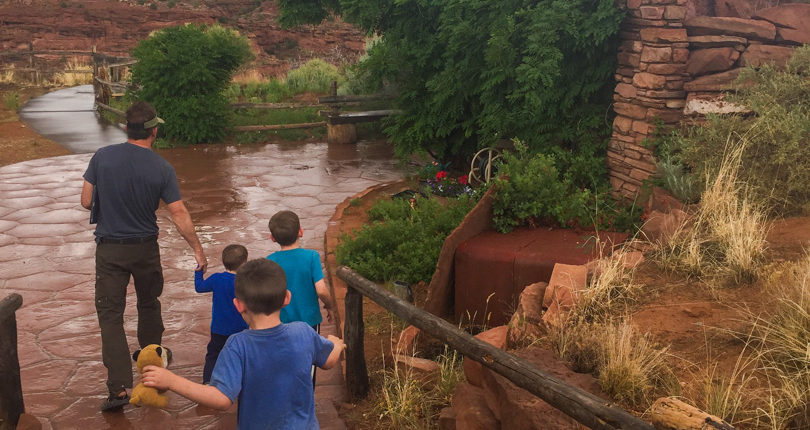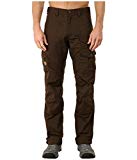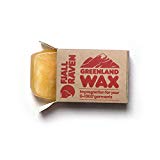It is rare for me to advocate “old school” over modern tech, but I’ve found a great method that I would like to share: waxing your polyester/cotton garments with good-old wax. I have taken to waxing my favorite Fjallraven Vidda Pro pants (this post will probably also turn into a plug for those great pants).
Here are the advantages of waxing for water resistance: 1) the pants wear like real pants, not crinkly loud plastic 2) they are water resistant… enough… while remaining truly breathable. In fact, you can dial in the amount of breathability/waterproof-ness you desire.
Here’s the problem with modern outerwear: it is either fully waterproof… or not. And either way, it still wears like plastic.
If a modern garment claims to be “water-PROOF”, it has taped seams and a Goretex “breathable” layer (or, if it’s super cheap, just fully coated nylon or even PVC). And in truth it doesn’t breathe worth a damn, no matter what they say. Don’t get me wrong, I own expensive Goretex shell layers and use them all the time for wet/windy/cold conditions. But they still don’t breathe well. Exert yourself a bit, and you’re shortly soaked in your own sweat.
On the other hand, if a garment claims to be “water-RESISTANT”, it is inevitably made out of nylon, treated with a DWR (durable water repellant), and lacks taped seams. The result is that it’s almost fully waterproof when you first buy it, and then it is barely even water RESISTANT after a year of active use… and still wears like a piece of plastic.
I like wearing pants with real fabric rather than plastic. That usually means including a certain amount of cotton. Yes, I know “cotton is death” in the outdoors, but really that adage is dramatically overblown. The G-1000 Fjallraven fabric that I love in my Vidda Pro pants is 65% polyester, 35% cotton, and it’s perfectly fantastic for hardcore adventures. It’s durable, doesn’t soak up water like jeans due to the polyester, and is comfortable enough to wear around as a daily pant.
Karen tells me that I need to provide concrete examples, so here: I wear these pants hiking 14ers with the boys, I wear them skinning up the ski hill in the cold dark before dawn, I wear them camping everywhere anytime, I also wear them to work when I oughtn’t to (because I don’t wash them often when I have waxed them). Evidently I also wear them to ride the Polar Express, to collect a christmas tree from the woods, and to enter a cute remote Utah coffee shop (Kiva coffeehouse) in the rain, as the pictures that Karen dug up indicate.
You want DWR? I’ll give you DWR. You know what the best “DWR” durable water repellant is? Good old-school WAX. Either beeswax, or paraffin, or a combination of the two. Up in Scandinavia they’ve been using it for centuries, and even have a name for their particular recipe: Greenland Wax. The Greenland wax seems to be a blend of three ingredients: beeswax, paraffin, and orange oil.
There are three companies that produce a commercially available wax: Fjallraven, Kuhl, and Otter. I have tried the Fjallraven and the Otter brands. The Fjallraven was great, except that I must be allergic to something in it because it itched me (perhaps the orange oil, whatever that is). The Otter brand was also just fine, though the bar was less strong and broke into fragments (which is still perfectly useable).
However when I went to buy another bar last month I decided hey, why not just mix my own? So I bought the “purest” paraffin and beeswax I could find off of Amazon, for $13 total, stuff without any fragrances or that nonsense (what am I making, candles?). Then I did the double-boiler thing on my stove, mixed them up in roughly equal parts, and poured the melted mix into a flexible silicone mold designed for ice-making (I think). My effort yielded 5 times the final quantity for the same price that I would have paid for the Kuhl brand bar. I include that process in my youtube video as well.
Ok, this is how you apply the wax: 1) rub it on. 2) melt it in. That’s it. It rubs on like a crayon, just color it in where you want it. To melt it in, you have some options. The most manly way to do it is around the campfire: put on the waxed pants and just rotate yourself in a vertical rotisserie motion while standing next to the campfire, and let the radiant heat do the work. It looks a bit funny, and requires some contortion—as well as a campfire. Alternatively, use a hairdryer. That’s how I do mine, as it is quick and easy and doesn’t risk burning the pants. You can iron it in easily as well, though that requires a bit of vigilance to avoid damaging the pants, and can also gunk up your iron (I suppose you could use the ski waxing iron, that hadn’t occurred to me until now).
What fabric can be treated with wax? Good question. I know that the entirely cotton Kuhl brand pants that are currently popular will work great with wax (hence the reason Kuhl sells their own wax bar for $15). I’m not entirely sure what range of fabric would work with wax. Probably anything with cotton in it.
Now, let me be perfectly candid about the drawbacks of waxing your pants (or anything else). First, it takes time. It takes about a half hour for each application, and it should be done maybe twice a year. Depending on how often you wash your pants. Which brings us to the second primary drawback: you can’t wash your pants with either hot water or detergent, or the wax will come out. This is convenient for the spring, in that you can easily strip the wax for summer breathability just by running it through the hot soapy washing machine twice. But through the winter, just don’t wash your pants. Or, if you absolutely must, use cold water no detergent and air dry them.
Personally, whenever I wear them through the winter, I wear them with an underlayer or two (underwear and long underwear both, for example), and I just let the outside get superficially dirty. A bit of mud and campfire smoke smell doesn’t count as really dirty to me. Granted, I don’t wear them to work that way, but these pants are almost too hardcore for work; they’re made for real outdoor activity, not sitting in an office chair. So I go as long as possible without even washing them, through the cold season.
I like waxing my pants. I like the hands-on, do it yourself aspect. I like that it takes time and thought, and that I’m intimately involved in the performance of my own pants. After I put in the effort, the result is superior to the waterproof/breathability ratio of off-the-shelf pants. They wear well, they keep me dry and warm, and the fabric is tough and comfortable.








